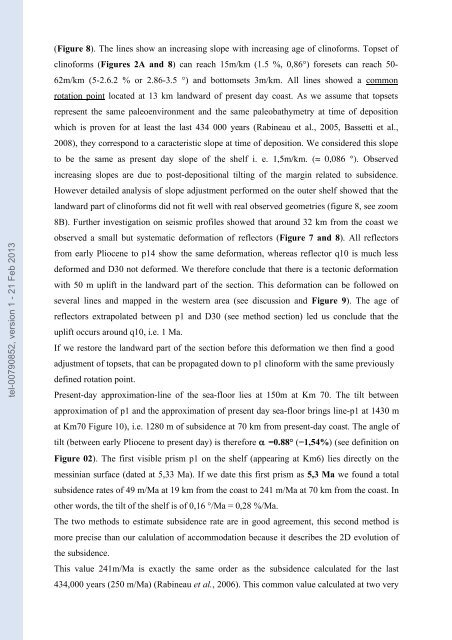Quantification des flux sédimentaires et de la subsidence du bassin ...
Quantification des flux sédimentaires et de la subsidence du bassin ...
Quantification des flux sédimentaires et de la subsidence du bassin ...
You also want an ePaper? Increase the reach of your titles
YUMPU automatically turns print PDFs into web optimized ePapers that Google loves.
tel-00790852, version 1 - 21 Feb 2013<br />
(Figure 8). The lines show an increasing slope with increasing age of clinoforms. Tops<strong>et</strong> of<br />
clinoforms (Figures 2A and 8) can reach 15m/km (1.5 %, 0,86°) fores<strong>et</strong>s can reach 50-<br />
62m/km (5-2.6.2 % or 2.86-3.5 °) and bottoms<strong>et</strong>s 3m/km. All lines showed a common<br />
rotation point located at 13 km <strong>la</strong>ndward of present day coast. As we assume that tops<strong>et</strong>s<br />
represent the same paleoenvironment and the same paleobathym<strong>et</strong>ry at time of <strong>de</strong>position<br />
which is proven for at least the <strong>la</strong>st 434 000 years (Rabineau <strong>et</strong> al., 2005, Bass<strong>et</strong>ti <strong>et</strong> al.,<br />
2008), they correspond to a caracteristic slope at time of <strong>de</strong>position. We consi<strong>de</strong>red this slope<br />
to be the same as present day slope of the shelf i. e. 1,5m/km. ( 0,086 °). Observed<br />
increasing slopes are <strong>du</strong>e to post-<strong>de</strong>positional tilting of the margin re<strong>la</strong>ted to subsi<strong>de</strong>nce.<br />
However d<strong>et</strong>ailed analysis of slope adjustment performed on the outer shelf showed that the<br />
<strong>la</strong>ndward part of clinoforms did not fit well with real observed geom<strong>et</strong>ries (figure 8, see zoom<br />
8B). Further investigation on seismic profiles showed that around 32 km from the coast we<br />
observed a small but systematic <strong>de</strong>formation of reflectors (Figure 7 and 8). All reflectors<br />
from early Pliocene to p14 show the same <strong>de</strong>formation, whereas reflector q10 is much less<br />
<strong>de</strong>formed and D30 not <strong>de</strong>formed. We therefore conclu<strong>de</strong> that there is a tectonic <strong>de</strong>formation<br />
with 50 m uplift in the <strong>la</strong>ndward part of the section. This <strong>de</strong>formation can be followed on<br />
several lines and mapped in the western area (see discussion and Figure 9). The age of<br />
reflectors extrapo<strong>la</strong>ted b<strong>et</strong>ween p1 and D30 (see m<strong>et</strong>hod section) led us conclu<strong>de</strong> that the<br />
uplift occurs around q10, i.e. 1 Ma.<br />
If we restore the <strong>la</strong>ndward part of the section before this <strong>de</strong>formation we then find a good<br />
adjustment of tops<strong>et</strong>s, that can be propagated down to p1 clinoform with the same previously<br />
<strong>de</strong>fined rotation point.<br />
Present-day approximation-line of the sea-floor lies at 150m at Km 70. The tilt b<strong>et</strong>ween<br />
approximation of p1 and the approximation of present day sea-floor brings line-p1 at 1430 m<br />
at Km70 Figure 10), i.e. 1280 m of subsi<strong>de</strong>nce at 70 km from present-day coast. The angle of<br />
tilt (b<strong>et</strong>ween early Pliocene to present day) is therefore =0.88° (=1,54%) (see <strong>de</strong>finition on<br />
Figure 02). The first visible prism p1 on the shelf (appearing at Km6) lies directly on the<br />
messinian surface (dated at 5,33 Ma). If we date this first prism as 5,3 Ma we found a total<br />
subsi<strong>de</strong>nce rates of 49 m/Ma at 19 km from the coast to 241 m/Ma at 70 km from the coast. In<br />
other words, the tilt of the shelf is of 0,16 °/Ma = 0,28 %/Ma.<br />
The two m<strong>et</strong>hods to estimate subsi<strong>de</strong>nce rate are in good agreement, this second m<strong>et</strong>hod is<br />
more precise than our calu<strong>la</strong>tion of accommodation because it <strong><strong>de</strong>s</strong>cribes the 2D evolution of<br />
the subsi<strong>de</strong>nce.<br />
This value 241m/Ma is exactly the same or<strong>de</strong>r as the subsi<strong>de</strong>nce calcu<strong>la</strong>ted for the <strong>la</strong>st<br />
434,000 years (250 m/Ma) (Rabineau <strong>et</strong> al., 2006). This common value calcu<strong>la</strong>ted at two very

















